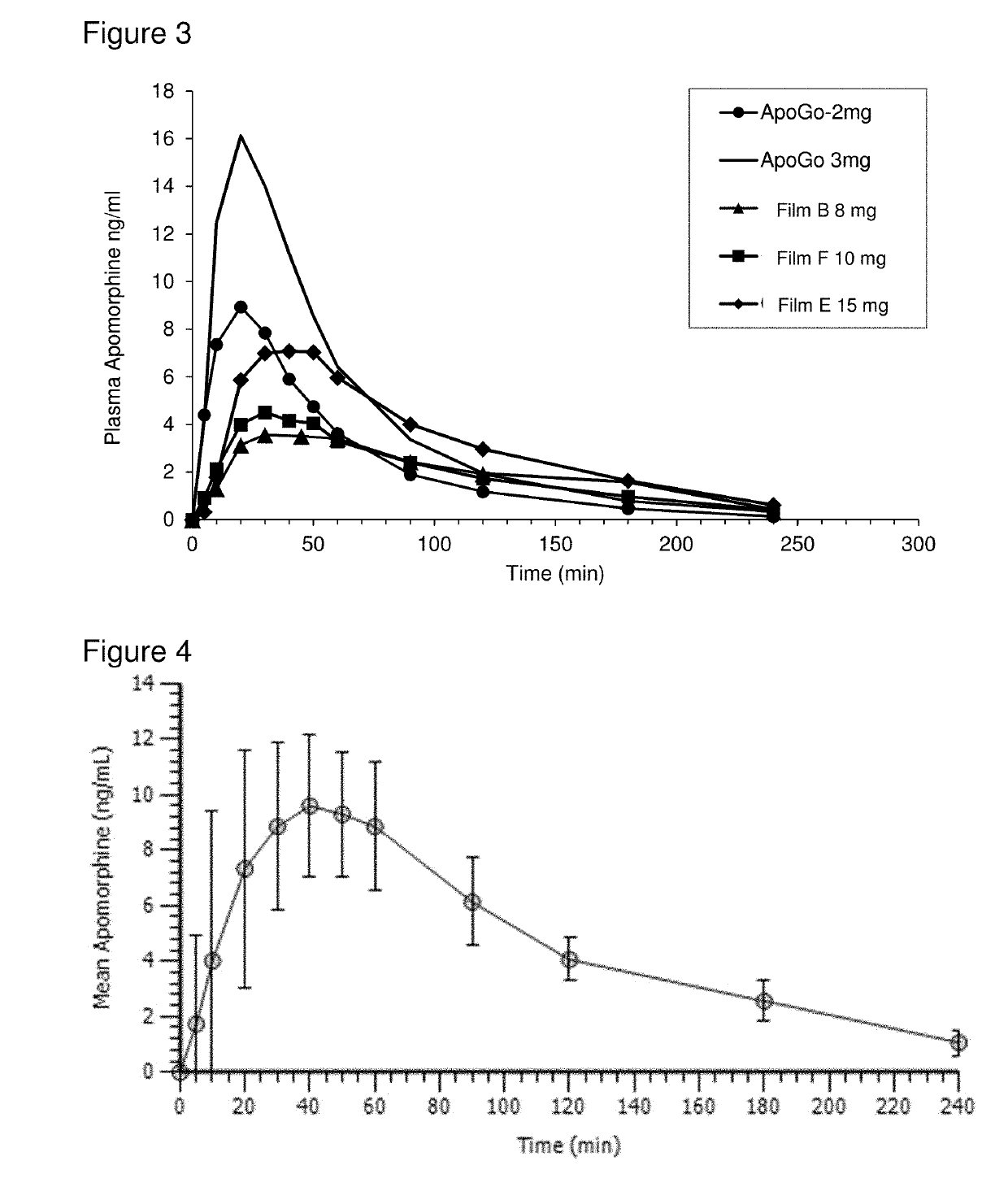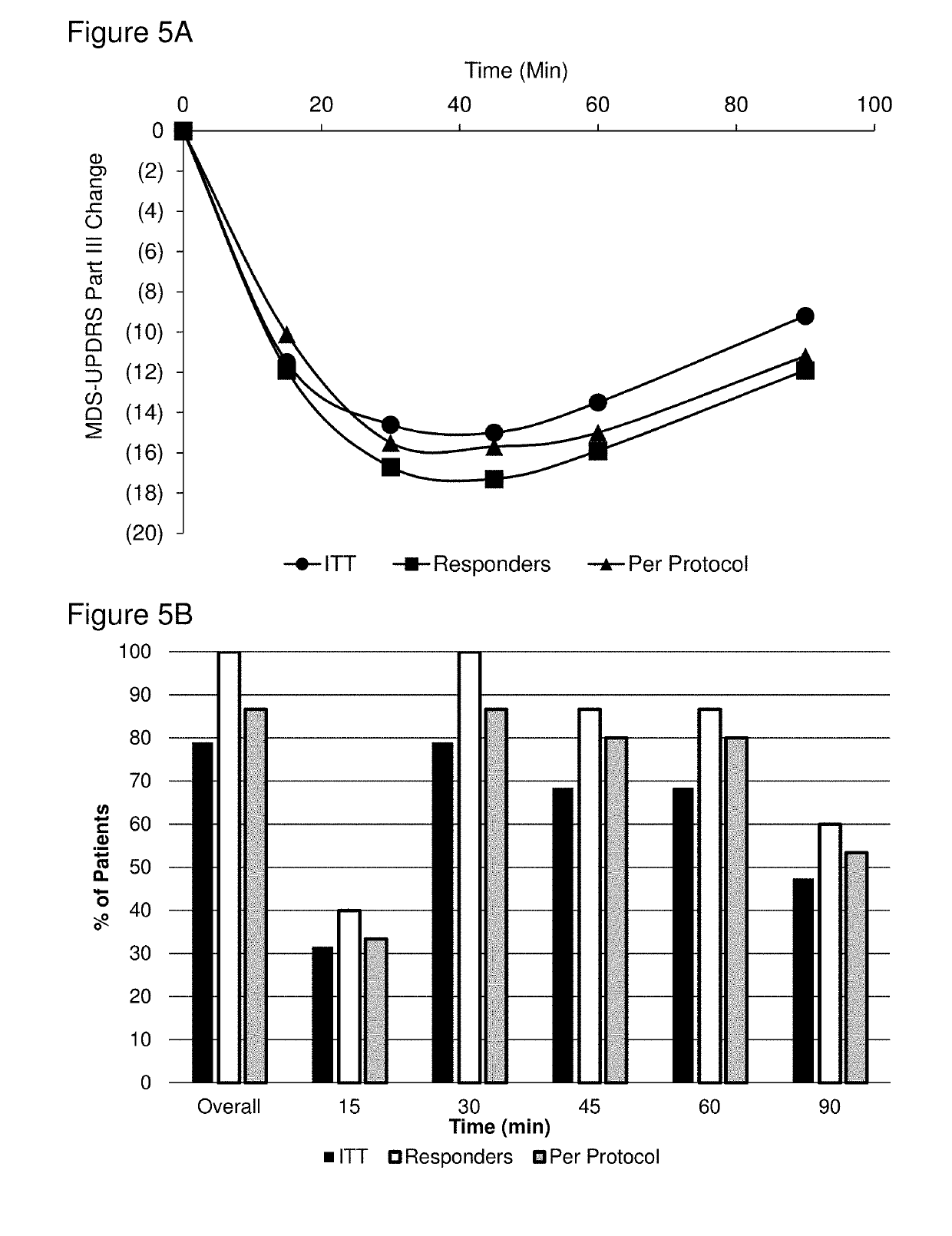Methods of treating parkinson's disease by administration of apomorphine to an oral mucosa
a technology of oral mucosa and apomorphine, which is applied in the direction of drug compositions, inorganic non-active ingredients, nervous disorders, etc., can solve the problems of increased stiffness of voluntary skeletal muscles, tremors, and inability to move and move rigidly
- Summary
- Abstract
- Description
- Claims
- Application Information
AI Technical Summary
Benefits of technology
Problems solved by technology
Method used
Image
Examples
example 1
Two Layer Apomorphine Film
[0126]Preparation of the Solid Solution Layer:
[0127]Sodium metabisulfite, disodium EDTA, propylene glycol, disintegrant, and sucralose are added to water and the mixture stirred. Acetone and menthol are then added to this solution, and the mixture stirred. Apomorphine hydrochloride is added to the mixture with stirring, forming a clear solution. Polysaccharide is then added slowly with stirring. The resultant mixture is placed under vacuum to eliminate air bubbles, cast as a uniform layer unto an inert support, and then dried in an oven to produce a film comprising a solid solution of apomorphine hydrochloride.
[0128]Preparation of the Particulate Layer:
[0129]Ethyl cellulose, poly(ethylene oxide), and hydroxypropylcellulose are dissolved in a solvent (e.g., water / acetone) to form a solution.
[0130]Particulate apomorphine hydrochloride is prepared by milling solid apomorphine hydrochloride as described herein.
[0131]The particulate apomorphine hydrochloride is ...
example 2
Tri-Layer Apomorphine Film
[0136]A first layer containing a rapid release solid solution of apomorphine hydrochloride, and a second layer that contains a slow release apomorphine hydrochloride particles are prepared as described in Example 1.
[0137]Preparation of the pH Neutralizing
[0138]Ethyl cellulose, poly(ethylene oxide), and hydroxypropylcellulose are dissolved in anhydrous ethanol to form a solution. To the resulting solution is added a pH modifying agent (i.e., pyridoxine).
[0139]A solvent-cast mucoadhesive film is prepared by casting a thin film of the solution onto the first layer. Evaporation of the solvent (ethanol) can be accomplished by drying at 60° C. for 30 minutes.
[0140]Preparation of a Tri-Layer Film
[0141]The 3 layers may be laminated together by applying a spray of ethanol between each pair of layers, assembling them as desired, and then drying them in an oven to form the final tri-layer film. The resultant dry tri-layer film includes (i) a first layer containing a r...
example 3
Single Layer Apomorphine Film Coated with Apomorphine Particulates
[0144]A first layer containing a rapid release solid solution of apomorphine hydrochloride is prepared as described in Example 1. The resultant dry film includes a single adhesive layer that is made of a rapid release solid solution of apomorphine hydrochloride. A surface of the film is coated with particulate apomorphine hydrochloride.
[0145]The particle-coated film can be cut into strips, each strip containing the equivalent of from 2 mg to 100 mg of apomorphine (free base mass). The strips can be administered to a subject for the treatment of Parkinson's disease.
[0146]The mole ratio of solid solution apomorphine to microparticulate apomorphine in the final dosage form can be controlled by varying the amount of apomorphine included in the rapid release layer and / or by controlling the amount of particulate apomorphine added to the first layer. The ratio can be from 1:9 to 9:1; 1:9 to 1:1, 1:1 to 9:1, 1:7 to 7:1; 1:7 t...
PUM
| Property | Measurement | Unit |
|---|---|---|
| concentration | aaaaa | aaaaa |
| concentration | aaaaa | aaaaa |
| weight average molecular weight | aaaaa | aaaaa |
Abstract
Description
Claims
Application Information
 Login to View More
Login to View More - R&D
- Intellectual Property
- Life Sciences
- Materials
- Tech Scout
- Unparalleled Data Quality
- Higher Quality Content
- 60% Fewer Hallucinations
Browse by: Latest US Patents, China's latest patents, Technical Efficacy Thesaurus, Application Domain, Technology Topic, Popular Technical Reports.
© 2025 PatSnap. All rights reserved.Legal|Privacy policy|Modern Slavery Act Transparency Statement|Sitemap|About US| Contact US: help@patsnap.com



